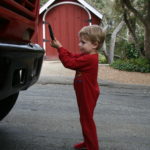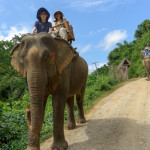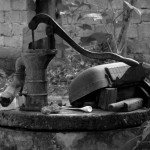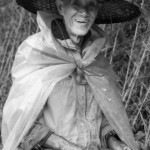Why do we travel — Why does anyone travel?
Let’s face it, traveling can be a royal pain in the arse. It’s expensive, it’s time consuming, it’s a risk, it’s often uncomfortable, but for a few of us it’s as necessary as oxygen.
The most common question we get when we start telling people about our crazy adventures is, why? Why would any sane person travel like you guys do?
Hey look, we get it.
Not everyone is born with wanderlust that drives them to the ends of the earth. We just happen to be that way. But we know lots of people who aren’t. Once on a bus trip while parked at a random Safeway somewhere in California, a couple walked by staring at our bus. This happens a lot, most people are overjoyed when they see us in our bus. But these two walked by slowly with looks of utter confusion on their faces. Finally, the woman turned to her husband and said, “That is my nightmare. Don’t ever make me live in one of those.”
Alrighty then! Give the woman credit for knowing what she doesn’t like. But, her nightmare is our playground. We love messing around on our bus. No matter if we are headed down the coast to San Diego, overland to Utah, or just up to Moss Landing for breakfast, we love being on the road, in a converted school bus.
I remember my first solo trip.
I was on my way to Puerto Rico to work in the rainforest with some crazy organization who my parents knew of from a family friend. All I knew was that I was getting on the plane and some guy was going to pick me up in San Juan and take me to the rainforest.
Years later my mom admitted that she had waited for me to turn around and give one final wave before disappearing down the jet way. I never did. It never even occurred to me to look back – why would I?
I had a backpack over my shoulder and a sleeping bag tucked under my arm. For the first time in my life I felt perfectly at ease. I was headed out, on an adventure, all was right in my world.
In college, I was known for bringing a packed suitcase to class so I could go straight to the metro and jump on a plane to skip across the Atlantic. Malone, too, was famous on his own college campus for being the crazy sophomore who jumped on a plane to London over fall break. A few days before a visiting student from the UK had bet Malone he would never come visit. He called his new friend from a phone booth at Victoria station a few days after the bet.
The thought of jumping on a plane and walking down the jetway into an unplanned adventure, if only for a quick weekend, appeals to us.
When I was pregnant with Bryce a good friend of ours, Carlos Mota, pulled Malone aside and told him point blank to keep traveling. He regaled Malone with stories of traveling with his two kids, all the times he went into hotel kitchens to clean baby bottles, of creating makeshift beds in various places, of being so exhausted he was barely able to speak at his speaking engagements, but that it was absolutely worth it. His kids were not afraid of anything and he and his wife were able to see the world through the eyes of their children.
We both agreed we wanted that more than anything for our kids.
We felt lucky to have found our love for traveling and wanted to pass on that fearless nature and absolute drive to explore new places to them. Looking back we both can see that our love for adventure and willingness to put up with travel hardships was passed down to each of us by our fearless parents – but that’s a story for another day.
Our kids are rugged, resilient adventurers. True wanderers of the earth, ready to jump at a moment’s notice, to try anything – once. To set sail, dive deep, dance in the rain, sleep on the floor, go to plan C, or D, or E. To laugh when all else fails. We could not have asked for better traveling partners.
Back to the question at hand. Why? No really, why?
When we meet people, or get to talking to the people we already know, they inevitably ask:
Why do you travel? Why do you want to go there? What will you do? What do you want to see? Truthfully, I often don’t know. Does it matter?
Sometimes I simply want to breathe in the air that’s on the other side the world.
I’m not a planner so when we arrive at a new place I’m just as surprised as everyone else about what happens next. (don’t tell them that ) I love arriving. Stepping off the plane and getting that first whiff of air sneaking into the jetway from a poorly sealed portal. Or better yet walking down the stairs right onto the tarmac with the wall of heat slapping you in the face as you stumble to find the stairs with your feet. Or watching the snow drift down and settle on the wings as you wait your turn to exit while you question your decision to pack the light weight jacket because it took up less space in the backpack.
Come on! How can that not be fun? I love traveling.
When we travel we put ourselves in other people’s way. We purposely involve ourselves in their world, their cultures, their lives. And often we put our very lives in their hands. Admittedly, that takes a special kind of faith in humanity.
The last time we were in Morocco we needed to get ourselves from Tangiers to Fez, which is about a five-hour drive, where we were to spend the night. But we also had planned to stop in a beautiful city called Chefchaouen known for its blue paint and magnificent streets, where we wanted to have lunch and a hike around the city. We had been told shared taxis were the way to go.
But, as I said, I’m not much of a planner so the plan was flawed and the hotel manager had concerns. He didn’t like the idea of us trying to find a taxi from Chefchaouen all the way to Fez at that late hour. He advised us to hire our own taxi, that he would arrange for us, all the way to Fez with an agreement to stop for lunch along the way.
That sounded like a terrific idea to us so we all agreed and off to the phones he went. All seemed great – there was no way the hotel manager would put us in a fake taxi, would he? No way. His entire livelihood rises and falls on trip advisor reviews so handing us off to someone who would rob us and leave us on the side of road would be bad for business, surly. Imagine the review! We felt all was well and we loaded our stuff and our children into the newly arrived taxi and took off.
However, things didn’t go as planned. Within a few minutes of our departure from the hotel our taxi driver got a phone call. He then excitedly told us that a buddy of his was from Chefchaouen and would take us because he just happened to be in town dropping off a fare.
Malone and I looked at each other and he immediately started calling the hotel. Our broken Arabic and our driver’s broken English might be part of the problem, but this seemed a little far-fetched to us. No answer at the hotel, no such thing as an answering machine, no better understanding of what was happening.
The boys perked up. They could tell something was amiss. The driver was excited, he didn’t have to drive all the way to Fez but would share some of the money. His buddy would get a fare all the way home. It was good to have friends in the same business, haha, life is good!
Malone took a deep breath and gave us all that look – stay calm but alert. We all sat up straight, we all listened carefully.
The boys took a photo of the driver.
The driver pulled onto a dirt road and stopped about 150 feet from the main road.
It was secluded.
We waited.
“He’s coming. He’s coming!” our driver told us. “No worry. Don’t worry.”
Here’s the thing. The vibe wasn’t wrong. That feeling you get when you know something bad is about to happen wasn’t there at all. The boys were joking with the driver, Bryce was translating as best as he could and giving me that eye that said this guy seems fine.
But we were stopped on a dusty side road, waiting for other people to arrive. I waited and hoped we hadn’t royally screwed up.
After a few minutes another car showed up and pulled in next to us. We all jumped out and introduced ourselves. Sure enough it was a lone driver in a nice car big enough for us and our stuff. Everyone moved our gear to the new car and our local driver did a thorough check to make sure we hadn’t left anything in his. Malone discreetly took photos of the two license plates, all the while laughing and joking with our new friends. We shook hands and piled into the new taxi.
The boys, ever aware, didn’t get into the car until we did, smart boys. We all piled in and roared off to Chefchaouen. We stopped for lunch while the driver went home and slept. He picked us up after a few hours and took us to Fez. It was good to have friends. There was no malice. No plan to rob us. He really was just a guy trying to find a fare back home.
It was a reminder of our faith in humanity. When we travel, we put ourselves directly in the path of other people and while doing so we have faith that they will do right by us. So far, 95% of the time, the people we have met do exactly that, thus keeping our faith in humanity high.
Maybe that’s why we travel. To remind ourselves that no matter who we are, where we live, where we come from, what we believe, what we are afraid of, or what we look like, people are thoughtful, kind, altruistic. Willing to help a crazy family. Willing to point the way to a lost soul. Willing to smile at a stranger. Willing to brighten the day with the only thing we really have in this world – ourselves.



